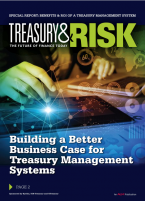 As more and more areas of a
business become data-driven, people throughout the organization
have an increasing volume of information at their disposal to
measure and monitor. This trend seems highly conducive to building
technology business cases brimming with precise ROI calculations,
but treasury leaders shouldn't be lulled into complacency.
As more and more areas of a
business become data-driven, people throughout the organization
have an increasing volume of information at their disposal to
measure and monitor. This trend seems highly conducive to building
technology business cases brimming with precise ROI calculations,
but treasury leaders shouldn't be lulled into complacency.
As German sociologist Steffen Mau argues in his book “The Metric Society: On the Quantification of the Social,” too much devotion to key performance indicators (KPIs) combined with too little judgment can lead to the gaming of scoring systems and other unpleasant outcomes. To be meaningful and effective in guiding business decisions, quantifiable metrics should be considered in the context of the broader, non-quantifiable goals of the initiative.
Treasury professionals who recognize and avoid the following missteps in making a business case for a new technology investment can increase their odds of a positive outcome:
1. Over-promoting productivity gains
Productivity gains are a popular, though frequently flawed, component of business cases, notes Bob Stark, vice president of strategy for Kyriba. Business cases for treasury management systems typically do address productivity gains, but Stark believes these measures should not be a pivotal part of the case. Total time savings generated by automating previously manual processes tend to involve numerous treasury professionals. As a result, the treasury team may gain a substantial increase in time available to devote to analytical and strategic work. But Stark says these time savings rarely, if ever, translate into staff reductions. CFOs, he says, “typically don't look at time savings as a realistic component of a business case.”
2. Looking too narrowly at the system and its uses
When assessing the current customer base of a treasury management system that has made their shortlist, some shoppers research how their industry peers are using the solution, then look no further. Instead, treasury leaders should expand their investigation to organizations outside their industry that have treasury functions with needs similar to their own, says Niklas Bergentoft, principal in treasury with Deloitte Risk and Financial Advisory.
“Further, don't look at a treasury management solution as the only technology to be used,” Bergentoft adds. “Look at the core of the solution and discern how your organization may want to augment it with other required technologies, offering the chance for your organization to leverage a more holistic approach to treasury management as well as other outcomes.”
3. Neglecting the human factor
Treasury teams typically measure the benefits of a new treasury management system 6 to 18 months after implementation. Their goal is to determine the extent to which the project has achieved its expected returns. When it falls short on these measures, there is a natural tendency to blame the technology. However, Bergentoft says, if the organization fails to realize the full value of the investment, the human element is more likely to be the cause than is the system itself.
Project plans governing implementations should pay close attention to the processes, workflows, and behavioral changes that need to be made in tandem with the introduction of new technology. “People have a tendency to revert back to old behaviors during and after solution deployments,” Bergentoft warns.
4. Underestimating the importance of data quality
Poor data can lead to inaccurate financial reporting, degradation in the ability to spot fraud, inefficient business processes, flawed business insights, and other problems. The potential consequences are severe: These issues can result in a loss of customers and market share, missed collections, financial restatements, incorrect tax determinations, regulatory fines, litigation, higher financing costs, and more, notes Roman Scheller, a senior manager with EY who operates in the firm's wealth and asset management group/ financial services organization.
Better data, on the other hand, fuels better strategic decision-making. “The data can be utilized to identify hidden patterns and trends to provide better business insights,” Scheller says. “It can be the basis to present a fuller picture of activities and to identify risks and process anomalies that matter, allowing treasury to direct improvement efforts to the right areas.” Although these benefits may be difficult to include in precise ROI estimates, they should be described in the business case for any system that would substantially improve the quality of treasury data.
Also from the April 2019 Special Report:
Sponsored Statement—Kyriba: The Value of a TMS Platform in Transforming Treasury
Sponsored Statement—ION: Seven crucial tips for selecting the best Treasury Management System for your business
Complete your profile to continue reading and get FREE access to Treasury & Risk, part of your ALM digital membership.
Your access to unlimited Treasury & Risk content isn’t changing.
Once you are an ALM digital member, you’ll receive:
- Critical Treasury & Risk information including in-depth analysis of treasury and finance best practices, case studies with corporate innovators, informative newsletters, educational webcasts and videos, and resources from industry leaders.
- Exclusive discounts on ALM and Treasury & Risk events.
- Access to other award-winning ALM websites including PropertyCasualty360.com and Law.com.
*May exclude premium content
Already have an account? Sign In
© 2024 ALM Global, LLC, All Rights Reserved. Request academic re-use from www.copyright.com. All other uses, submit a request to [email protected]. For more information visit Asset & Logo Licensing.


 Article:
Article: 




